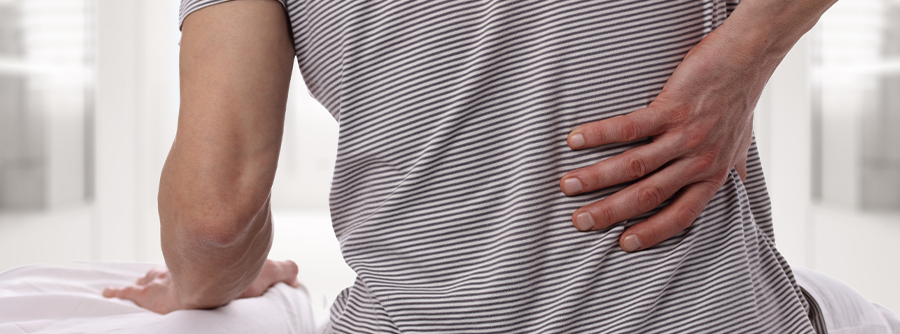First of all, what is scoliosis?
Scoliosis is a permanent deformation of the spine (or rachis) in all three planes of space (front, side and transverse).
This deviation of the spine is linked to a rotation of the vertebrae in relation to each other. In scoliosis, the spine is twisted and its natural curves are altered. This condition results in gibbosity (a hump-shaped deformity of the upper back).
It is important to differentiate between "true" scoliosis and scoliotic attiture. In fact, in the case of scoliosis, the deformations of the spine are invariable in all positions (sitting, standing, lying down) whereas in the scoliotic attitude the curvatures normalise (disappear) when unloaded. In other words, when lying or sitting, the torsions disappear. Most of the time, this is a vertebral attitude developed to compensate for the tilt of the pelvis, whatever its origin.
Idiopathic scoliosis generally appears during growth and accelerates at puberty.
It affects an average of 0.5 to 2% of 8-15 year-olds, with girls statistically eight times more affected than boys.
With treatment, scoliosis stabilises. However, it sometimes continues to develop into adulthood.
"Secondary" scoliosis is due to a neuromuscular or bone disease (e.g. unequal length of the lower limbs, osteoporosis) or occurs following a neuromuscular disease (e.g. myopathy) or bone disease (affecting the vertebrae in particular). In children, it is much rarer than the idiopathic form. It often affects children with cerebral palsy.
Adult scoliosis is idiopathic scoliosis that appeared in childhood, did not stabilise by the end of adolescence and continues to progress into adulthood.
De "novo" scoliosis occurs late in life and is due to age-related degeneration of the intervertebral discs and vertebrae. It is becoming increasingly common as people live longer.
What are the symptoms of scoliosis?
Idiopathic scoliosis in children and adolescents usually develops gradually during growth. It generally progresses slowly before puberty, then accelerates during this period and is often asymptomatic. Scoliosis should be systematically screened in children and adolescents. This is why a systematic inspection of the back is recommended once a year in children and teenagers. Detecting scoliosis as early as possible is essential for effective medical treatment.
In adults, on the other hand, scoliosis chronically causes spinal pain (lumbago, neck pain or back pain). Most of the time, however, the condition is asymptomatic. It can only be detected by a medical examination.
Diagnosing scoliosis
To detect scoliosis, the doctor carries out a medical examination of the patient. If, at the end of the consultation, scoliosis has been detected, the doctor will ask for x-rays of the entire spinal column, front and side.
The X-rays enable the diagnosis of scoliosis to be made and the extent of existing deformities to be assessed: extent of scoliosis, vertebrae affected.
They also make it possible to measure the amplitude of the major curves of the spine: this is the Cobb angle, expressed in degrees (the angle formed by the upper and lower vertebrae of the scoliosis).
X-rays can also be used to search for a possible cause (vertebral malformation, extra vertebrae, etc.), and to monitor the development of scoliosis over time.
In addition, X-rays of the left hand and wrist, the elbow in children and X-rays of the pelvis in adolescents are necessary to determine the patient's bone age and adapt the treatment. Depending on the case and the treatment envisaged, other examinations may be necessary: CT scan, MRI, breathing tests if the scoliosis is large enough to affect lung capacity, etc.
The aim of scoliosis treatment
Treating a patient with scoliosis is a multidisciplinary process. It requires the collaboration of various health professionals: the treating physician, paediatrician, orthopaedic surgeon, rheumatologist, physiotherapist, orthoprosthetist, etc.
The main aim of the treatment is to limit the worsening of the spinal deformity. In the case of children and adolescents, it is vital that the deformity should be as moderate as possible by the end of growth!
There are several treatment options, depending on the severity of the condition:
- Simple monitoring when the scoliosis has little curvature, giving way to treatment if the deviation worsens,
- Orthopaedic treatment with a corset. This is the main treatment proposed for children and adolescents with progressive scoliosis. The corset is used to support the spine to reduce the risk of worsening pathological curvatures. There are different types of corset, and in all cases the device is made to measure from a mould of the body, to ensure it is as well-fitting and well-tolerated as possible.
- Surgery. This may be indicated if orthopaedic treatment fails for scoliosis that continues to progress. It consists of correcting spinal deformities using metal rods attached to the vertebrae. Bone grafting is often performed.
Whatever the treatment, if the patient experiences pain associated with scoliosis, painkillers may be prescribed at the same time as the treatment, and sometimes, in adults, infiltration under radiological guidance may be considered. At the same time, alternative medicine can be effective.
Functional re-education using physiotherapy is carried out in parallel with any treatment and helps to maintain spinal mobility and respiratory function. It strengthens axial muscle tone to improve vertebral support.
Paralegal treatment also offers many advantages. Manual medicine, acupuncture and magnetotherapy can relieve patients of pain and significantly improve physiotherapy and orthopaedic treatment.

